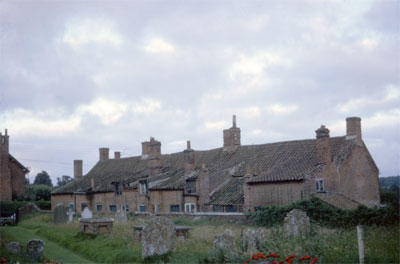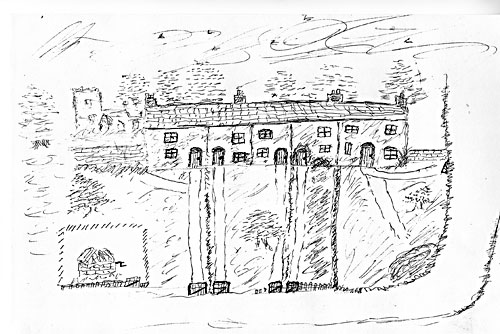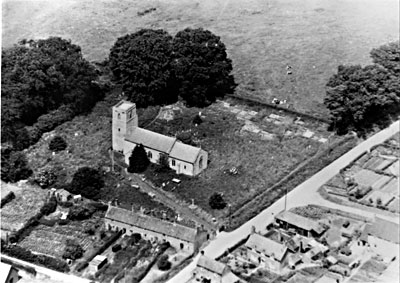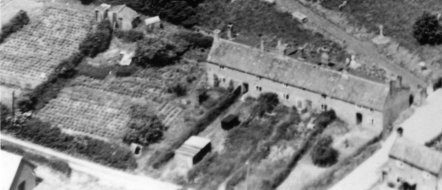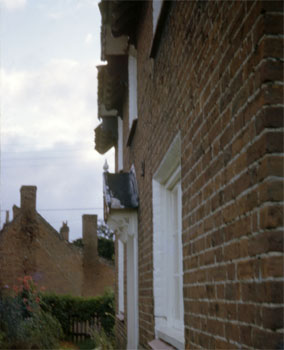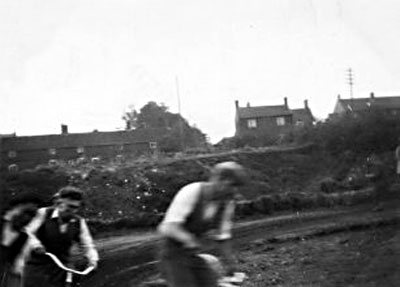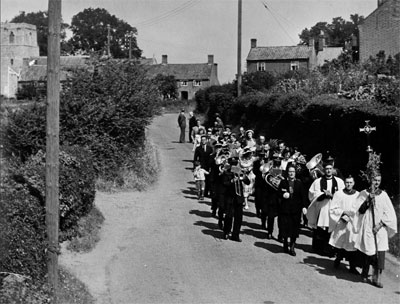Having survived unscathed the early blitz period of the war, by late 1943, air raids had become fairly infrequent, and people were becoming fairly relaxed. This ended with the onset of Hitler's last fling, with V1 flying bombs, and the V2 Rockets.
After the V1 had destroyed the school and damaged several other buildings in Wembley High road, evacuation of children from the area was again considered essential.
My parents decided to send me to the small village of Itteringham, in Norfolk, to stay with a family who were acquainted with my cousin Chester Dickenson, at the time serving with the RAF at a nearby airfield.
Having travelled with my mother by train to Aylsham, we completed the journey to Itteringham by taxi. It seemed like a very long journey, but in reality it was only a few miles.
The Family I was staying with was named Broughton. The mother was a widow, and there were two boys around my own age, named Freddy & Denis, and an older boy in his teens. There were two girls, one around twelve years old and another was a teenager named Dulcie
The house was the first in a row of four farm workers cottages known as Church row. There were two downstairs rooms, and three small upstairs bedrooms. At the front of the building, adjacent to the front door was the entrance to a small storage area for firewood which also contained a wood fired boiler, known as a copper, used for laundry.
There was no piped water, and no electricity in the house. Lighting was by two large brass oil lamps, hanging in the center of each of the downstairs rooms. Each of these rooms also had a cast iron cooking stove, which served for heating in the winter as well as cooking. There was no heat in the upstairs bedrooms.
Since the houses were built on a slope, the back room was slightly lower than the front, resulting in a step down between two halves of the ground floor rooms. In the winter, the family used the upper part of the downstairs area, and the lower part, opening on to the garden was used in the summer. The house also possessed two large Tom-cats, which were half wild, and made their own arrangements for food.
For decoration in the cottage, there were a number of stuffed birds and small animals in glass display cases fastened to the walls.
There was also a pantry and store cupboard leading off from the lower room, containing among other things a large galvanized pail full of drinking water. Shortly after my arrival, I asked for a drink of water, and was given a cup, and shown the pail of water in the pantry. Accustomed as I was to getting water from a tap, the thought came into my young head that the people in the house were trying to poison me.
The downstairs floors in the cottage were of flagstones. These were partially covered by rugs made from strips of old rags sewn on to a backing of sackcloth. They were laid out in front of the little cast iron ranges in the upper and lower areas of the house. They seem to have been particularly attractive to the house cats.
Each of the cottages had a garden at the rear, with access to the old fashioned windlass well which served all four homes. Behind this was a lane leading to a farm. The village Hall and what was then a sandpit, was on the other side of this lane.
The front door of each of the cottages opened into a narrow passageway bounded by a flint faced wall, about four feet high, on the other side of which was the churchyard. The passageway led to the Shared vegetable garden at the far side of the cottages, and a small shed containing four outside toilets, one for each home. These were foul smelling ‘Thunderbucket' latrines, which from time to time had to be emptied. For night-time urination only, there was a chamberpot in each bedroom.
Behind the row of toilets was an area given over to vegetable gardens and chicken runs, as well as a deep square pit into which the contents of the thunder-buckets from the toilets were emptied. When the pit was two thirds full, it was back filled with earth and another pit was dug elsewhere in the garden area.
The cottagers kept a variety of domestic fowl in the wire runs in this area, including ducks and bantam chickens. These were generally fed on ground up kitchen scraps. Most people also kept rabbits, and these were generally fed on certain weeds and herbs collected from the hedgerows as well as cabbage stalks etc.
At the time of my evacuation there was no piped water in the village. There were a number of wells, each serving about half a dozen houses. These were the classic design, consisting of a brick lined shaft about four feet across, rising about three feet above ground. The water, which was crystal clear, was about twenty-five feet down, and was drawn up in a galvanized pail by a rope and windlass. There was a little roof covering the well, supported by the wooden posts to which the windlass was attached. The galvanized pail remained in the well. The water from this was poured into another container, which was kept in the house.
Although there were a few houses in the village connected to the electric service, there was no connection to Church Row. The cottages were lit by candles and oil lamps.
The oil lamps were of the old fashioned design, with a wick that needed trimming every day. They burned paraffin oil, which gave off its characteristic stench when burning.
I do not recall seeing any pressurized oil lamps, such as the “Tilley” anywhere in the village. One soon became so accustomed to the smell of paraffin oil, that it was no longer noticed.
There was also a battery radio in the house, but it was rarely used. The big batteries were expensive, and the glass accumulator needed to be charged regularly, but in the winter it was occasionally switched on and the whole family would sit round listening to it.
The village school was a two-room building with a tarmac playground surrounding it.
There was one teacher who was probably in her thirties, but to a seven year old looked like an old lady. Due to the wartime staff shortages she had to manage things alone.
The children were divided into two groups by age, the younger ones in one room, and the older ones in the other. The teacher would take the class of older children, and delegate one of the older and brighter girls to look after the younger group.
Pupils above a certain age were driven to Sheringham each day to attend the school there.
The toilet facilities at the school were in keeping with the rest of the village, consisting of a row of four thunder-bucket stalls set against the wall at the back of the playground.
The contents of the filled buckets were emptied over the wall to join the existing malodorous mountain of dung and straw from the adjacent farm's cowsheds and stables, ultimately to be spread on the fields as manure.
Situated about a mile from the village, one of the favorite playgrounds for the local boys was Mannington sandpit, (pronounced Munt'n sandpit by the natives.) This sandpit was used as a firing range by several of the local airfields, and there were always a wealth of bright brass cartridge cases, both live and fired, lying around in the sand. Most of these were .303 rifle bullets, but a few revolver rounds could be found and these were highly prized. I recall on one occasion helping to carry a small sack of live 303 rifle cartridges home, and hiding them under the hedge behind the vegetable garden. The boys had no use for these, except to look at, and the instinct to collect bright things must have been akin to that of Magpies and Ravens. The cartridges are probably still there, although the sack would long ago have rotted away. On one visit we found an unexploded hand grenade, which I stayed well clear of, but the other boys examined it closely. By a miracle it never exploded. It is well said that God looks after drunks and little children.
Close to the sandpit, there was a ruined Church, which at the time was held to be haunted by the local villagers. Nobody would go near the place at night.
Towards the end of Summer, it seemed the whole village turned out to collect firewood for the winter. Surprisingly large tree trunks and branches were dragged, sometimes several miles from the surrounding woods. It is possible that the local villagers enjoyed the ancient right to collect fuel, known as ‘Fire Bote' dating back to Saxon times. It is unlikely that the owners of the woods welcomed this annual incursion. The wood supply had to last out the winter, but the fireboxes on the cooking stoves were very small, so a little went a long way.
The smell of the wood fires in the village was very pleasant on winter evenings, compared to coal smoke, which I had grown up with in Wembley
The same woods that were the source of firewood were predominantly sweet Chestnut, and in the autumn when the nuts were ripe, they were gathered by the village children.
In addition, many of the hedgerows were hazel, and again the children would go out in groups and collect these Hazel nuts, which were delicious when fresh picked from the bushes.
Most of the farms around Itteringham grew wheat or barley, and when the time came to harvest this, most of the village population would turn out to help. To cut the Wheat, a “Binder” was used, pulled by an old Fordson tractor with spiked rear wheels. The spikes had to be removed when traveling on the road. These old tractors had dual fuel tanks, one of which contained petrol, and the other paraffin oil. The engine was started on petrol and when it had warmed up the fuel line was switched to paraffin. The Binder machine would cut the crop, and tie it into bundles, which were then ejected behind. A group of workers would follow the Binder and stack the bundles upright into “Stookes” to dry. The machine would start at the edge of the field by the entrance gate, and work around the field in a spiral. As remaining area to be cut grew smaller, the Rabbits, which had been sheltering in the crop, would break cover and make a dash for the hedges at the edge of the field. They would be met by an occasional shotgun, as well as dogs and boys with sticks enthusiastically giving chase, hopeful of rabbit stew for supper. About half of the rabbits made it to safety.
Once the cut crop had dried and was ready for threshing, the stooks would be collected from different fields either on a farm cart pulled horses or a tractor, or possibly by an ancient Thornycroft lorry with solid tyres, and taken to the threshing machine which had been set up in a convenient central point. This machine was driven by a steam traction engine using an enormous four-inch leather belt, which by some miracle managed to remain on the flat drive wheels. I recall watching this belt with fascination for long periods, listening to the regular click as the joint in the belt passed over the flywheel and the chuffing of the steam engine.
Another major crop in the area was sugarbeet, and harvesting this was a labour intensive and back-breaking job. The farmhands would work backwards across the field, grasping the beet by its leaves, and pulling it out of the soil. When two had been uprooted, they had to be banged together to remove the loose soil, after which the worker would move back to the next two beets and repeat the process. When the field had been cleared in this manner, another group would remove the leaves with a sickle, and load the beet into a truck or farm cart to be taken to the factory for processing.
On another occasion, whole families including children would gather to pick blackcurrants, payment presumably being made by weight of berries picked. A good many were also eaten by the children.
Across the lane behind the Church Row cottages was the village hall. I recall an occasion when the Vicar managed to get a magic lantern and a film projector, and gave the population of the village a treat. The film show was mainly black and white cartoons, with some music hall acts, including sand dancers. A good time was had by all.
My winter in Itteringham in 1944, was one of the coldest on record, with snow drifting to a depth of three feet or more. There was a little water filled ditch behind the village pub, which was frozen almost solid, and made a good slide. For small boys wearing short trousers the snow would be above the knees, but I have no recollection of feeling particularly cold, and we would go out to play in the road in the morning at least half an hour before school started.
During the war the whole county was dotted with airfields. Perhaps the closest was at Matlaske, and I recall the thrill of seeing three fighter planes taking off, on an occasion when we ventured further than normal from the village. At the time, the hedges close to the airfield were covered with aluminum foil strips, known as ‘Window', used to jam German radar.
Another airfield used by American bombers was on the road to Aylsham, close to Blickling, but we never wandered that far from home. However, I can recall the discussion among adults in the village when a returning bomber had crashed and burned on that airfield.
The closest popular play area to the Church Row cottages, was the sand pit across the lane, and adjacent to the church hall. This small open area, was bounded by Church Road on one side, and a small swampy thicket of trees and alder bushes, known locally as ‘The Car' on the other. The sandpit extended down as far as the schoolhouse. On the other side of ‘the car' was a small brook running into the river Bure a little upstream of the bridge. There was a small footbridge crossing the brook behind the area now known as the Big Yard, and close to this footbridge, was an area generally used as the village rubbish dump. We used to search the area from time to time looking for prized empty jam jars, used for fishing in the brook where it passed under the lane. There were both three spine and ten spine sticklebacks, as well as stone loaches in the brook, in addition to lampreys, known as blood suckers, which were much sought after as a delicacy by Italian POW's working on local farms. Dead electric light bulbs were also popular, as floating targets for stone throwing.
Another summer pursuit by young boys in the area was bird-nesting and the collection of birds eggs. Searching the hedgerows in late spring was a popular pastime, although most birds, particularly blackbirds tended to build their nests in thorn bushes and were therefore unreachable. There were many more wild birds about at that time, and it was even possible for collectors to buy wild birds eggs commercially.
There were also many varieties of butterflies, many of which are quite rare today, that we enthusiastically chased but rarely captured. In the evenings we would stay out until dusk, at which time the mothers in the village would stand outside and call their children home. Each woman had her own recognizable call, and they could be heard at a distance that would make an army Sergeant Major green with envy.
The village policeman, a much respected and universally feared figure, lived in a house on the other side of Church Road, a few hundred feet from the entrance to the church.
He rode a heavy framed large wheeled bicycle. The most serious crime in the area at the time was probably small scale poaching.
There were numbers of Italian POW's working in the area at that time. Primarily it would seem in clearing out the drainage ditches in areas of reclaimed swamp. Many of these prisoners made baskets and woodcarvings, which they would try to exchange for a few shillings or a bar of soap that was in short supply at the time. They were generally of a cheerful and friendly disposition, no doubt glad to be out of the war for the duration.
At the end of the war I returned home to Wembley with a strong Norfolk accent which took me several months to lose, and a love of the country which I retain to this day.
Tony Rock - 22nd March 2012 |
